The environmental movement took a big leap forward in 1969 as a result of an environmental catastrophe. Here we review that event and other disasters of human origin that are remembered less for their impact on Mother Nature than for the upheaval they brought to society. We learnt lessons from them that have led to greater protection of the natural environment.
Cuyahoga: the river that caught fire (1969)
During the 20th century, one of the largest industrial centres in the USA flourished around Cleveland (Ohio). Parallel to this industrial development, the Cuyahoga River, which flows through the city, also quickly rose to the top of the pollution list. The Cuyahoga was so full of flammable substances and floating debris that from time to time its surface would catch fire. More than a dozen fires were reported on the river until, in 1969, some floating mass of fire caught the attention of Time magazine. The magazine published spectacular photos of the river that “oozes rather than flows.”
The article and photos rattled American society and led to major changes. Until then, local industries could dump waste into rivers unchecked. In the wake of the Cuyahoga fire, a movement in the USA in defence of the environment was also ignited. Incoming president Richard Nixon read the mood of the nation with respect to environmental issues and after the first Earth Day (22 April 1970), Nixon responded by creating the federal Environmental Protection Agency (EPA). The Cuyahoga fire, which flows into Lake Erie, also prompted an agreement between the US and Canada to protect the Great Lakes on the border between the two countries. And one year later, the federal Clean Water Act came into being.
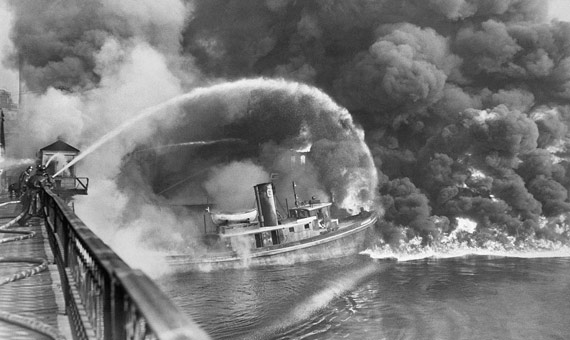
Echoes of that 1969 river fire still resonate today in pop songs (by R.E.M. and Randy Newman), and the disaster also inspired an annual music festival in Cleveland, the Burning River Fest. But it was actually not the most serious fire on the Cuyahoga River. The fire of 1952 had been much larger and caused much greater losses. In fact, the famous Time magazine photos were from 1952, as in 1969 the photographers arrived at the river too late, after the fire had already been extinguished. The local media did not even pay much attention to the disaster that spawned environmental controls in the USA.
The Cuyahoga of today is very different from that of 1969. The recovery of the river, an effort that is still ongoing, has ensured that even the most polluted stretch between Akron and Cleveland has achieved most of the goals set by the Clean Water Act, although in recent years there have been warnings about its microbiological pollution. Curiously, in August 2020, the media reported that the river had caught fire for the 14th time, the first time in 51 years; fortunately, this time the cause was not pollution of the river itself, but a tanker truck accident on the highway. However, the incident highlighted the risk still posed by roadside sewers discharging directly into the river.
Three Mile Island Nuclear Power Station (1979)
On 28 March 1979, an accident occurred at the Three Mile Island nuclear power plant in Harrisburg, Pennsylvania. Following a partial core meltdown in one of its two reactors, the alarm was quickly raised and the television reporters covering the story were caught up in scenes of panic, bewildered by the invisible threat of radioactivity.
An undetermined amount of radioactive gas was released into the environment. However, the radioactive contamination detected in the vicinity of the plant was much less than in accidents such as Chernobyl (1986) and Fukushima (2011). And epidemiological studies did not find a cause-effect relationship between the accident and the slight increase in cancer cases in the region near the nuclear power plant. Nevertheless, the clean-up work took 14 years and cost over a billion dollars.
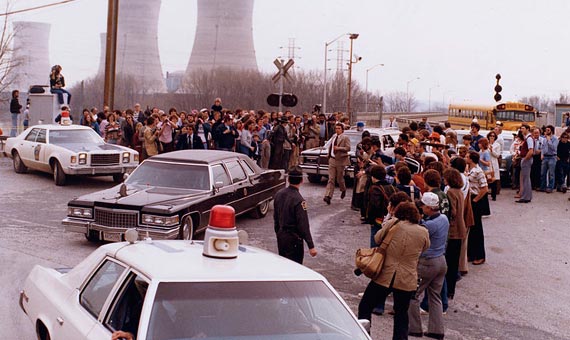
Once again, the environmental disaster (the most serious nuclear accident in the US) had social and legal consequences. The anti-nuclear movement was revived, and the nuclear industry saw itself subject to new legislation. The accident also had media consequences. Walter Cronkite, the legendary TV news anchor, referred to the media coverage of Three Mile Island as “the most confusing day in the history of the news media.” Between the contradictory statements of experts and the lack of knowledge of basic nuclear physics on the part of almost all of the 300 reporters on the ground, news chaos ensued.
Both the communication media and the journalism schools realised the need to train reporters specialised in covering science and technology. As a result, that same year the first postgraduate programme in science writing was launched at the Massachusetts Institute of Technology (MIT), followed by similar courses at the University of California and New York University.
Today, the Three Mile Island plant remains inactive. Reactor 2, which caused the accident, stopped operating when the accident occurred and was never started up again, with fuel removal and decontamination taking place in the decades since. Reactor 1 continued to operate until September 2019. However, the full decommissioning of the plant will not be completed until 2079, one hundred years after the accident.
The Seveso disaster (1976)
Seveso is a town near Milan that would be unknown outside Italy were it not for an accident at a small chemical plant that manufactured pesticides. Toxic gases reached nearby towns, exposing tens of thousands of people to the highest levels ever recorded of a dioxin: specifically TCDD (2,3,7,8-tetrachlorodibenzo-p-dioxin), one of the most lethal of these substances and known for a component of Agent Orange, used by the US in the Vietnam War.
No one died in the so-called Seveso disaster, in contrast to what happened after the most infamous gas leak in history: in 1984, another pesticide plant in Bhopal (India) caused nearly 4,000 confirmed deaths and left more than half a million people affected. In Seveso the immediate aftermath was panic and evacuations. 80,000 animals were slaughtered to prevent toxins from entering the food chain, and several thousand people were treated for dioxin poisoning.
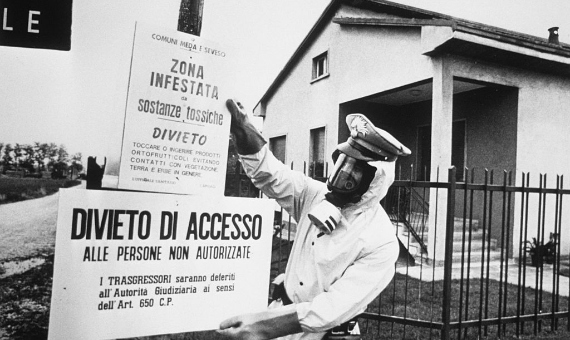
In the long term, scientists have been able to learn many lessons from Seveso, thanks to the doctors having kept blood samples from all the patients. Decades after the accident, scientific studies continue to be published that analyse the large amounts of data from this dioxin exposure. In addition, industrial safety regulations were standardised in Europe. The accident led to an EU law known as the Seveso directive, which regulates the handling and storage of hazardous chemicals.
The Bhopal disaster and others prompted an update of the Seveso directive in 1996. The so-called Seveso-II was in turn updated again in 2012 to a third version, Seveso-III, which mainly focuses on informing the public about the risks from nearby chemical installations. At the site of the accident there is now a park known as Seveso Oak Forest Park with two artificial hills, beneath which the toxic remnants are stored, protected in concrete sarcophagi; the rest of the soil is free of dioxins.
Times Beach, the slow catastrophe (1982)
In December 1982, the town of Times Beach, Missouri, suffered the worst flooding in its history when the Meramec River overflowed its banks. The event would have been no more far-reaching than similar disasters, so common around the world, had it not been for the dioxin-laden soils in the town, something that had already been reported at the time, because the story of the Times Beach disaster had begun to unfold more than ten years earlier.
In the late 1960s and early 1970s, a chemical plant in Verona, Missouri, manufactured a component of Agent Orange and a disinfectant, both of which produce the by-product dioxin TCDD, which the operating company stored in a tank. The disposal of this waste was left to Russell Bliss, owner of a small used motor oil collection business. Bliss mixed the plant’s waste with the oil in his tanks, which he used to spray on the soil of his horse farm to prevent dust in the air. His anti-dust solution was so effective that other farmers began to hire him, and in 1972 even the Times Beach town council enlisted his services to spray oil on all its dirt roads.
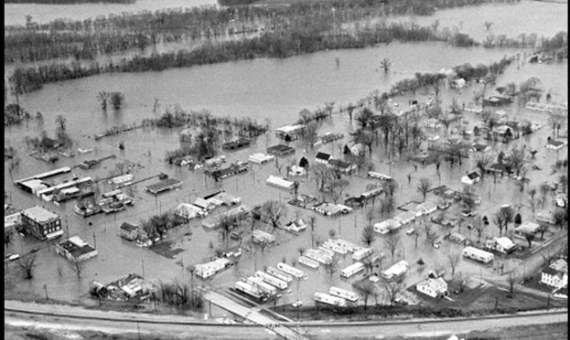
The effects of Bliss’s miracle solution were soon revealed as horses and birds died and children fell ill. The U.S. Centers for Disease Control and Prevention undertook an investigation and detected contaminants in the soil, but at the time the effects of dioxins were not well known. The EPA was slow to get involved, and soil sampling was completed just the day before the 1982 flood spread contamination throughout the town. Analysis revealed a concentration of dioxins 300 times above safe levels, but it was too late; Times Beach had to be evacuated in its entirety.
The events in Missouri in the 1970s spurred the creation in the USA of the so-called Superfund (formally the Comprehensive Environmental Response, Compensation, and Liability Act, CERCLA) for the decontamination of hazardous waste sites. Thanks to this initiative, the Times Beach clean-up was completed in 1997 at a cost of 200 million dollars at the time. Today, the town of Times Beach no longer exists; since 1999, the Route 66 State Park, dedicated to this historic road, has been located on its former site.
The Exxon Valdez oil spilll (1989)
Marine spills of oil and fuel are unfortunately all too frequent, and always catastrophic for ocean ecosystems, coasts and their populations. The Deepwater Horizon disaster in the Gulf of Mexico in April 2010, the worst accidental spill in the history of the oil industry, is still fresh in our minds. But probably the one that has most marked the course and the actions taken against this type of disaster was the Exxon Valdez disaster in 1989.
On 24 March 1989, the Exxon Valdez supertanker collided with a reef in Prince William Sound, off the southern coast of Alaska. The accident spilled a minimum of 11 million gallons of crude oil, a disaster that could have been much worse, as the ship was carrying 53 million gallons. The amount spilled was much less than in other similar events. But the special sensitivity of a pristine ecosystem far from the open ocean and the remoteness of the site, which made it difficult for emergency crews to access, resulted in an ecological catastrophe: an estimated quarter of a million seabirds died, along with several thousand mammals and other species, affecting thousands of kilometres of coastline.
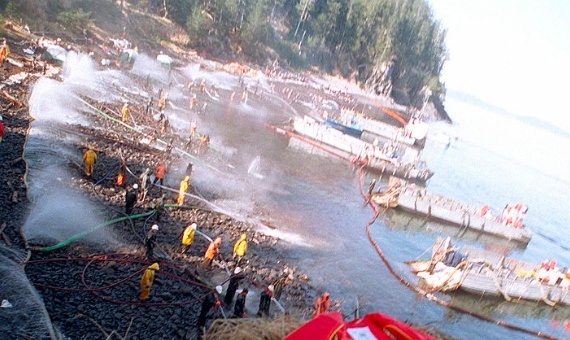
The Exxon Valdez case prompted the Oil Pollution Act of 1990 in the US, which tightened oversight and measures to prevent such disasters and regulated the response to them, forcing the industry to adapt. The Act mandated the transition to double-hulled vessels in the US to prevent or at least minimise spills. However, the oil giants have been slow to react due to the higher cost of these ships. In 1992, the International Convention for the Prevention of Pollution from Ships (MARPOL), now signed by 156 states, made it mandatory for all new tankers to be double-hulled, and for existing tankers to be retrofitted.
As for the ship itself, it was repaired and renamed Exxon Mediterranean in 1990. It then changed hands several times and continued to transport oil, and later ore, until 2012, when it was finally decommissioned. Despite clean-up efforts, the Prince William Sound area has never fully recovered. Even today, if you dig a little on many Alaskan beaches you can still find the remains of the spill.
.
Comments on this publication